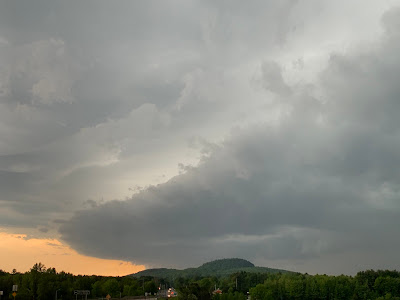 |
A sea of lilacs in my St. Albans back yard this
morning awaits a very summer like week in Vermont |
On a lovely Sunday in at least western Vermont, the temperature got up to 81 degrees in Burlington, launching what will be four or five consecutive days of 80s summer warmth.
Eastern Vermont was mostly in the clouds Sunday, but they should break out into partly sunny skies like the rest of us for most of this week.
The heat and humidity will build most of this week, and that means the risk of thunderstorms. There might, or might not be some strong ones mixed in on a couple days this week, but that depends on how things shape up in the atmosphere.
Yesterday, I said the chances of storms this week would be touch and go. That idea hasn't changed.
VERMONT HEAT
Let's get into temperatures first. The temperature and humidity forecasts here are fairly high confidence, at least through Wednesday. We'll probably get close to what is outlined below
The main story is the warmth will continue to build, and so will the humidity.
Today will be somewhat more humid than Sunday was, but I wouldn't go so far as to call it uncomfortable. Dew points, a good approximation of how icky you'll feel out there, should get up into the upper 50s to near 60 or so.
That's a bit much if you're doing strenuous outdoor exercises, but otherwise not bad. Temperatures should reach the low 80s for many of us.
Tuesday looks warmer and more humid. The heat will be tempered by clouds, especially in the afternoon (which I'll get into in the storm section below). So expect highs for most valleys in the 80-85 degree range. Dew points go into the low to perhaps mid 60s in some spots, so it will feel sticky, but not anything like the wilting humidity you might feel in places like Florida,
Wednesday will be the worst day of the week. Temperatures will get well into the 80s. A few places might touch 90, but for now anyway, forecasters have sort of backed off the idea of widespread low 90s in the valleys. We'll have to wait and see on that.
But not matter what happens, temperatures in the mid and upper 80s with dew points well into the 60s mean an oppressive day. We're not used to this kind of thing yet, either, so that will make it feel worse.
My ever-loyal husband has responded to my pleas to install the air conditioner in the bedroom window, as I think we'll need it for a couple nights this week.
Thursday's a wild card, both in terms of weather and temperatures. It all depends on when an expected cold front blows through. If it's early, we'll have a pleasant cooldown by afternoon. If it's later in the day, we'll have to wait until Thursday night to see relief.
In any event, we should be back to refreshingly cool by Friday, if current forecasts pan out.
STORMS
The forecast regarding storms this week is lower confidence than the heat predictions, for sure.
 |
NOAA's Storm Prediction Center has us in northern
New England in a marginal risk for severe storms
Tuesday (dark green). That's the lowest in a five point
alert scale. At least we're not getting a large scale
severe outbreak like that big yellow and
orange area in the Midwest. |
Today, there's a low chance a shower or storm could develop in the rising warmth this afternoon. If that happens, they'll be isolated, brief, and probably cling to mountains or maybe in northern New York where a cool Lake Champlain breeze could interact with warm air a bit inland.
Tuesday is still huge wild card. One key ingredient for storms is warmth and humidity, and we'll have that. A weak disturbance coming in could provide enough lift to trigger showers and storms
If things come together just right, a few afternoon or evening storms could become strong to severe.
Whether this happens depends on a few things.
Some of the computer models get a little over-excited when they see batches of thunderstorms upstream from us and "think" we will end up seeing the same. But those upstream storms can screw up our chances of having much thunder and lightning here.
"Debris clouds" - chunks of high and middle level clouds torn off the top of those thunderstorms far to the west - could largely block the sun. The sun's heat contributes to the instability that can trigger storms. Without that sun, the necessary instability just might not be there for the storms.
Also, the path of the upper level disturbance that would trigger the storms matters. If it goes too far north or too far south, we don't get the conditions for a big storm. For now, NOAA's Storm Prediction Center has us in a marginal risk for severe weather, the lowest in a five point alert system for such dangerous weather.
I think we might know more about the storm potential by early tomorrow morning.
Regardless of what happens, not everybody will see a storm tomorrow. If they do crank up, they'll be hit and miss.
When we get to Wednesday, only a few pop up storms might get going here and there in the sultry air.
Thursday is yet another wild card. If the cold front gets here in the morning, then we'll see just regular old showers, maybe a local downpour and a rumble of thunder. Yawn.
If the cold front arrives in the afternoon or evening, that would give a chance for the sun to go to work on the humidity. That would put the risk of severe storms on the table. We'll honestly have to wait until at least Wednesday to work out that forecast.























